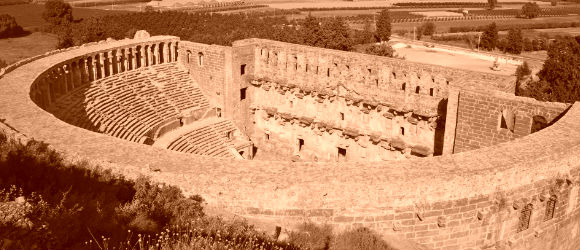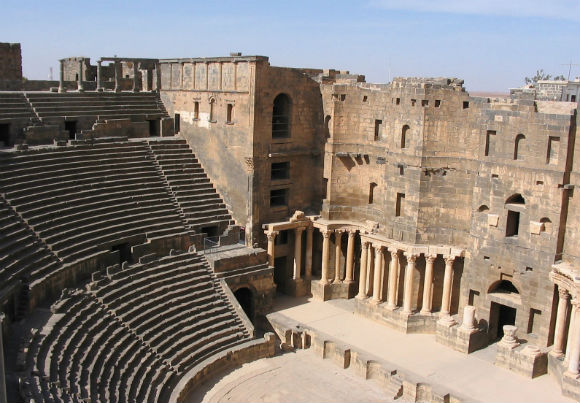Aspendos was an ancient Greco-Roman city in Antalya province of Turkey. It is located 7 kilometres (4.3 mi) northeast of central Serik.
Aspendos was an ancient city in Pamphylia, Asia Minor, located about 40 km east of the modern city of Antalya, Turkey. It was situated on the Eurymedon River about 16 km inland from the Mediterranean Sea; it shared a border with, and was hostile to, Side. According to later tradition, the (originally non-Greek) city was founded around 1000 BC by Greeks who may have come from Argos. The wide range of its coinage throughout the ancient world indicates that, in the 5th century BC, Aspendos had become the most important city in Pamphylia. At that time the Eurymedon River was navigable as far as Aspendos, and the city derived great wealth from a trade in salt, oil, and wool.
Aspendos did not play an important role in antiquity as a political force. Its political history during the colonization period corresponded to the currents of the Pamphylian region. Within this trend, after the colonial period, it remained for a time under Lycian hegemony. In 546 B.C. it came under Persian domination. The face that the city continued to mint coins in its own name, however, indicates that it had a great deal of freedom even under the Persians.
In 467 B.C. the statesman and military commander Cimon, and his fleet of 200 ships, destroyed the Persian navy based at the mouth of the river Eurymedon in a surprise attack. In order to crush to Persian land forces, he tricked the Persians by sending his best fighters to shore wearing the garments of the hostages he had seized earlier. When they saw these men, the Persians thought that they were compatriots freed by the enemy and arranged festivities in celebration. Taking advantage of this, Cimon landed and annihilated the Persians. Aspendos then became a member of the Attic-Delos Maritime league.
The Persians captured the city again in 411 B.C. and used it as a base. In 389 B.C. the commander of Athens, in an effort to regain some of the prestige that city had lost in the Peloponnesian Wars, anchored off the coast of Aspendos in an effort to secure its surrender. Hoping to avoid a new war, the people of Aspendos collected money among themselves and gave it to the commander, entreating him to retreat without causing any damage. Even though he took the money, he had his men trample all the crops in the fields. Enraged, the Aspendians stabbed and killed the Athenian commander in his tent.
When Alexander the Great marched into Aspendos in 333 B.C. after capturing Perge, the citizens sent envoys to him to request that he would not establish that he be given the taxes and horses that they had formerly paid as tribute to the Persian king. After reaching this agreement. Alexander went to Side, leaving a garrison there on the city’s surrender. Going back through Sillyon, he learned that the Aspendians had failed to ratify the agreement their envoys had proposed and were preparing to defend themselves. Alexander marched to the city immediately. When they saw Alexander returning with his troops, the Aspendians, who had retreated to their acropolis, again sent envoys to sue for peace. This time, however, they had to agree to very harsh terms; a Macedonian garrison would remain in the city and 100 gold talents as well as 4.000 horses would be given in tax annually.
In 190 BC the city surrendered to the Romans, who later pillaged it of its artistic treasures. Toward the end of the Roman period the city began a decline that continued throughout Byzantine times.
Aspendos,



When you enter to Aspendos it is fell like I use to fight like a gladiator who fight for freedom. I felt Roman Empire power, I felt slave who was building Aspendos. There are many ways to descibe it. If you like a little bit history never miss that places. If you are in Alanya the best way is contac…
In Aspendose two grandiose ancient constructions – an amphitheater and an aqueduct have well remained. Theater Aspendosa has left very pleasant memoirs, especially because we have got on an opera "Aida". Theater Aspendosa has been constructed in II AD by the Greek architect Zenon. In diameter it more than 90 meters also contain about 10000 spectators. Annually in the middle…
Don''t miss this most intact theatre from Classical Times
Breathtaking.
The gladiator outside was a nice touristy touch.
We were very lucky we got to see Swan Lake at Aspendos, it was fabulous try and catch a show there, the acoustics are magnificent Aspendos is Astounding
Stayed in Antalya and visited the amphitheater at Aspendos in the evening to watch Swan Lake.A capacity crowd clearly thoroughly enjoyed the ballet and the superb orchestra that accompanied them. A superb setting for this ballet but take a cushion.
If you like roman history, you'll enjoy visiting this amazing location. The pictures can barely do it justice. My family & I enjoyed walking around the ruins & having an ice cream afterwards.
WOW!
What a fantastic surprise, to come across this huge Roman amohitheatre on our travels. We were able to walk all around, including into the tunnels under the seating. The opportunity to have a photo taken with a Roman centurion was another highlight.
This place is a little dearer than other attractions in Turkey, but is well worth the admission…
Informative and well preserved place, worth a visit if you like history.
Acoustics are great..wonderfully preserved, ver impressive. Worth seeing it…drive by the aqueducts. Gift shop and food pricey.
We visited Aspendos on a trip booked through out tour operator Thomson. The cost was £25 in 2010 and included a visit to Perge. It was a half day trip picking up at around 9 and ending around 13.30.
The ampitheatre is very grand and is apparently the most complete in the world with over 90% being original.
The fact…